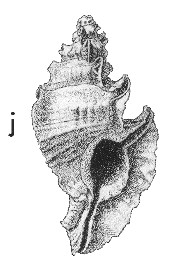
Revised descriptions of New Zealand Cenozoic Mollusca from Beu and Maxwell (1990)

 | Revised descriptions of New Zealand Cenozoic Mollusca from Beu and Maxwell (1990) | 
|
  (Pl. 48j): holotype of P. angasi powelli, Castlecliff, Wanganui, Castlecliffian (TM3115, GNS) |
Beu & Maxwell (1990): Chapter 16; p. 356; pl. 48 j.
Synonymy: Pterynotus (Pterochelus) angasi powelli Fleming 1962b, p. 114; doubtfully distinct from Typhis angasi Crosse 1863, p. 86, Murex eos Hutton 1873a, p. 8, and Pterochelus paupereques Powell 1974, p. 199; Pterynotus (Pterochelus) angasi; Pterynotus (Pterochelus) eos; Pterotyphis (Prototyphis) angasi powelli, Beu & Maxwell 1990, p. 356, pl. 48j.
Typhis angasi Crosse is type species of Prototyphis Ponder, 1972
Classification: Muricidae: Tripterotyphinae
Description: Small for family (25-40 mm high), with 3 wide, thin, lamellar varices per whorl, united up spire to form triangular plan. Spire slightly shorter than aperture and canal. Sculpture of several low, indistinct, narrow, widely spaced spiral cords below obvious shoulder angle on last whorl, 4-6 low nodules on shoulder angle in each intervariceal space, long, open, semitubular spine on shoulder of each varix, and thin, lacy frills on anterior (adapertural) face of each varix. Aperture small, oval, with smooth, reflected lips. Fasciole prominent, formed by former anterior canals. Anterior canal moderately long, clearly open. Protoconch of 1.5 smooth whorls, the apex flat or concave, the last half-whorl evenly convex.
Comparison: Fleming (1962) divided "Pterynotus" angasi into three subspecies — the Castlecliffian fossil P. angasi powelli, the New Zealand living P. angasi eos, and the Australian living P. angasi angasi — and Powell (1974) named the New Zealand subtidal, long-spined, spirally striped form as the "species" P. paupereques. However, examination of a much larger range of material than was available to Fleming or Powell showed that all these forms are highly variable in colour, size, sculpture, and length of spines, and even P. paupereques appears likely to be part of the variation of P. eos. P. eos is consistently differentiated from the Australian species P. angasi by minor characters; Houart & Héros (2008, p. 473) listed both P. angasi and P. eos as valid species of Prototyphis, when describing a new species of the genus from Fiji. Most species of Prototyphis occur in New Zealand, including small Eocene and Early Miocene fossils, but P. angasi lives in the intertidal zone in eastern Australia, and P. gracilis Houart & Héros, 2008 is the first species recorded from outside Australasia.
Fossils are uncommon at Castlecliff in several beds; most recently collected specimens are from Pinnacle Sand at "the pinnacles" gully. Fleming (1962) recorded a single poorly preserved Nukumaruan example from Wanganui. Three specimens from Devil's Elbow, Hawke's Bay (Nukumaruan), in off-shore siltstone, may belong in this species, but are at least twice as large as modern Prototyphis angasi and P. eos specimens we have seen, and have a long shoulder spine. The Altonian species P. awamoanus (Pl. 20s) is smaller, has more numerous shoulder nodules, and has a more inflated protoconch than P. eos.
The occurrence of Prototyphis eos in Wanganui Castlecliffian beds from at least Kupe Formation to Pinnacle Sand is a further indication of the relatively warm temperatures at Wanganui during the time of deposition of these formations.
Distribution: Nukumaruan?; Castlecliffian (-Recent?); Castlecliff, Wanganui, Castlecliffian (type of P. angasi powelli); Recent, south-eastern Australia (type of P. angasi Crosse); Recent, intertidal, Bay of Islands, north-eastern New Zealand (type of P. eos); Recent, 9-18 m, Poor Knights Islands, north-eastern New Zealand (type of P. paupereques). P. eos is rather rare today beneath large boulders and in rock crevices from low tide to about 30 m, throughout the north-eastern North Island from at least Doubtless Bay to Whangarei Heads (and probably to East Cape).
Cite this publication as: "A.G. Beu and J.I. Raine (2009). Revised
descriptions of New Zealand Cenozoic Mollusca from Beu and Maxwell (1990). GNS
Science miscellaneous series no. 27."
© GNS Science, 2009
ISBN
978-0-478-19705-1
ISSN 1177-2441
(Included with a PDF facsimile file
copy of New Zealand Geological Survey Paleontological Bulletin 58 in CD version
from: Publications Officer, GNS Science, P.O. Box 30368 Lower Hutt, New
Zealand)